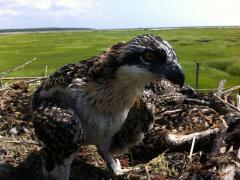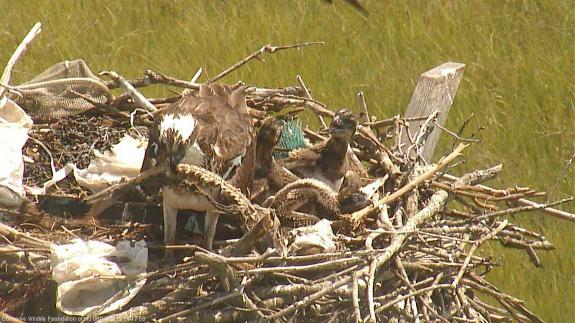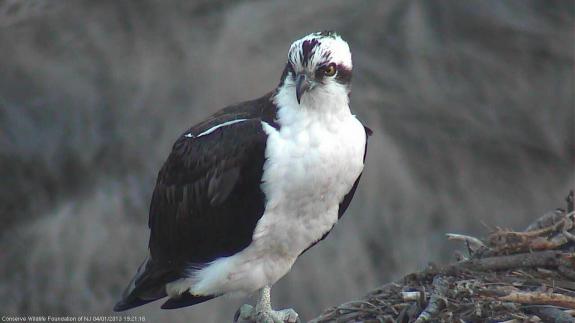2013 Nest Cam News
Summary of news from the 2013 Osprey Cam season written by Ben Wurst.
2013 Nest Cam News Summary:
November 21: Yesterday we visited the Osprey Cam to re-install the two batteries that power the camera system. They were removed in late October after being found with only half a charge (6V). Basically, they had too low of a charge for the charge controller to kick in and charge them, so they had to be removed, charged, and then re-installed. All systems powered right up and the feed was online in minutes. We were able to adjust the camera and everything is working just fine. We did notice that a raccoon has been hanging out on top of the battery box and has even climbed on the camera pole (from scat and scratch marks left in the wood poles). Before the end of the year we'll go back one more time to install predator guards on both poles to keep them off of the equipment and to prevent any premature damage to wiring, etc... At the same time we'll clean the camera dome and do some other minor fixes before winter really sets in.
October 28: Well, to an osprey biologist, it's a quiet time of year...sort of. While most ospreys are already on their wintering grounds in N. South America, we're busy scheduling maintenance and repairs to existing nesting platforms. We at CWF like to take a pro-active response to any kind of damage to nesting platforms to prevent the chance that a nest might topple with young in it...(it's never occurred on our watch).
We are planning on visiting the osprey cam nest at Forsythe this week to re-install the two deep cycle batteries. They were removed a couple weeks ago after they were found to only hold 6 volts. After being charged they now hold 12 volts and should accept a charge. We don't really know why the whole system went down in late July. Was it the charge controller? Possibly. We replaced that already. Once the batteries are installed and all systems are go then we hope that the camera will stream all winter long to get any other action that might occur on the coastal saltmarsh this winter. The sound feed is something we hope to figure out and get online before next March.
August 5: Today I got a chance to visit the nest to inspect the camera equipment. No lights were on in the equipment box so I disconnected the fuses and all lights started coming back on. I heard the camera motor and sealed everything back up. I wanted to only be out there as little as possible (no more than 5 minutes) and left. I got back to the parking lot and saw the stream on my iPhone. By the time I got to the Visitor's Center it was streaming again. After another 15 minutes the feed went down.... Right now I have no idea what is causing it to cycle off again. If it doesn't come on again then we'll have to wait it out until after the young fledge. At least I grabbed a couple screen shots... -Ben
July 22: We got word that all three young have fledged!! :) On Sunday they were seen perched on the top of the camera pole and on the solar array at the nest. They were also seen flying around the nest as a group. What great news! We only wish that we were able to share that moment with you... Now that we know the young have fledged we are planning to visit the nest for a quick inspection to see if the camera can be easily repaired. Stay tuned for updates!!
July 15: Unfortunately the Cam went down last night around 22:00hrs. We inspected all the networking equipment in the Visitor's Center at Edwin B. Forsythe NWR this afternoon and all is well. There was no data being sent to the recevier on the building, so that means that there is a problem out at the nest. At this time (the young are now 7 weeks old) we can not enter the nest site and introduce stress to the adults and young. Entering the nest site would cause the young to fledge prematurely, and with the given climate it is too hot to go out and cause this type of stress. We're sorry, but we're putting the health and well-being of ospreys first. It might come back online, but until the young fledge we will not be able to go out and fix the problem.
Please take the time to visit your National Wildlife Refuge system and go see the nest in person! Thank you all so much for viewing the camera and supporting our efforts to keep the osprey population at a sustainable level.
 The three six week old nestings at Edwin B. Forsythe NWR in Oceanville.
The three six week old nestings at Edwin B. Forsythe NWR in Oceanville.
July 7: The nestlings now look like the same size as the adults as they are 6 weeks old and in another 1-2 weeks, they will fly for the first time. In the meantime, they will strengthen their flight muscles by flapping their wings and "hopping" on the nest to take short flights off the nest. They are still fed by the adults but may feed themselves if food is left in the nest. They'll remain near the nest after fledging and will start to learn the skills needed to find and catch prey before dispersing locally, then migrating south in late August and early September.
 Zoom+ One of the three nestlings that were banded at Edwin B. Forsythe NWR in Oceanville, NJ on June 27th. © Ben Wurst
Zoom+ One of the three nestlings that were banded at Edwin B. Forsythe NWR in Oceanville, NJ on June 27th. © Ben Wurst
June 28: On June 27, we set out with volunteers, guests, and colleagues to band the three 4 week old nestlings. I have to say that it was quite the experience getting to and from the nest, as it has been for this whole project. One thing people realize when they see what field work is all about is that it is "always an experience!" To get to the nest we first had to use two 20' ladders to cross a 30' wide ditch. The ladders bridged the ditch by using a small marsh island as a stepping stone. I thought the tide had already peaked in the morning, but as we were crossing I realized the water coming into the ditch... Once we crossed the ditch we walked out on the high marsh and crossed one other ditch with a ladder. Once we made it to the nest we used two ladders to access the nest and band the young and remove any hazardous debris from the nest. The young were banded with aluminum bird bands that are provided by U.S.G.S. Bird Banding Lab. The bands are sized to fit the bird as an adult and they will not outgrow the band. The banding not inhibit the ability of the birds to forage and in New Jersey the oldest banded osprey that was encountered was 16 years old. The band numbers are: 0928-14745, 0928-14746, and 0928-14747. Each has this number and a 1-800 # on it so if anyone were to encounter one of these birds after they fledge then we would be able to track the birds back to this nest site.
- Live videos of the banding are available on our YouTube channel.
June 24: Four weeks old and ready to be banded! Each year, in late June and early July, biologists and volunteers conduct osprey nesting surveys by boat. These surveys help keep track of the health and growth of the osprey population in New Jersey. Last year ospreys had great year where 599 young were produced from 331 nesting pairs. While conducting the surveys these surveyors also band osprey nestlings before they can fly. In 2012, a total 431 young were banded for future tracking. You can read full results from last years survey here. This year we're conducting a statewide census to determine the total size of the population. Click on one of the census links to learn more about how you can help us!!
 The adult female positions a fish skeleton in the nest as the three week old wonder what she's doing.
The adult female positions a fish skeleton in the nest as the three week old wonder what she's doing.
June 14: It's amazing to be able to watch how fast osprey young grow! The oldest chick is now 20 days old (hatched on May 25). By three weeks of age the young are becoming more and more active and move all around the nest. This pair had some pretty interesting experiences this week... First, an old fishing net was brought into the nest and one chick ended up sitting on the net and when the two adults tried to move the net, they almost dumped that chick onto the ground. Then, after moving the net they ended up covering up the chick with the net and it was covered for over 15 minutes... Watch both of these "Close Calls" unfold in a two part series on our YouTube channel.
In other news, we are excited to announce the 2013 Osprey Census, a state-wide survey of all active nests in New Jersey. This year we are collecting observations from the public to help determine the size of the state population, which we believe is upwards of 550 nesting pairs.
June 4: All three young have been getting fed around the clock. The oldest is 10 days old and the youngest is 7. Osprey eggs hatch in the order they were laid (since ospreys start incubating after the first egg is laid). The young do compete for food in the nest. The older young are often fed first, since they are bigger and stronger than the younger ones, however, if there is enough food (which there has been) then all young are fed. This adaptation allows for only the strongest young to survival, especially when food is scarce.
May 28: There are now three chicks! The second chick hatched in the early afternoon on 5/26 and the third must have hatched sometime early this morning.
 The third chick must have hatched late last night. Here is the female now feeding three healthy chicks this morning!
The third chick must have hatched late last night. Here is the female now feeding three healthy chicks this morning!
May 26: Hatching has begun! One chick was reported to have hatched sometime yesterday night. It was seen by our staff at 11pm.
May 22: Today is day 35 of incubation. In New Jersey the average number of days that eggs are incubated is 35-37 days, up to 43 days. Hatching should occur sometime in the next day or two for the first egg and shortly thereafter for the remaining two eggs.
May 17: The pair has now been incubating three eggs for 24 days. Ospreys start incubating after they lay the first egg, which was laid on April 17. Keep an eye out for hatching, starting around May 19. The eggs will hatch in the order they are laid after incubation for 32-43 days.
May 3: We had quite a scare this week, after the female who was incubating, got a single use plastic bag wrapped around her neck! After posting this photo (below) to our Facebook page we got a lot of comments about what we were doing to help. To sums things up briefly: our stance was that we could only watch and hope the female could free herself. People wanted us to go out to the nest and help. Entering the nest at that time would have only caused more stress for the bird and would have caused her to fly off the nest, possibly even with the bag around her neck, causing more harm to her. If she would have been tied down to the nest for an extended period of time, then we would have intervened. Luckily, she was able to free herself. We have video of it and plan on putting it up on YouTube shortly. During the incident I looked up stats on plastic bag recycling and it's pretty poor. According to the U.S. EPA in 2010 only 12% of bags were recycled. Whether people recycle them or not, it's a good reason to make the switch to reusable bags! -Ben
 Here you can see the single use plastic shopping bag around the female's neck. She had quite a struggle to get it off...
Here you can see the single use plastic shopping bag around the female's neck. She had quite a struggle to get it off...
April 26: We have confirmed that the pair is incubating three eggs! Ospreys incubate for 32-43 days, so hatching will begin in mid-late May. Ospreys exhibit asynchronous hatching, so young hatch in the order they were laid. This adaptation gives the oldest young more advantage, especially during times when prey is scarce, where only one chick might survive.
April 22: Happy Earth Day!! The pair is now on two eggs. The second egg was laid on 4/20. The third should have come by today. One viewer posted on our FB page that she got a glimpse of three eggs but wasn't totally sure. We'd know for sure if the cam was still online, but after visiting the site and rebooting the Synology DiskStation (which is used for video recording) we lost remote access to the cam and the live stream. We're headed back tomorrow afternoon to figure out what happened...stay tuned!
April 16: We observed egg laying behavior today and the first egg was laid sometime this evening around 5-5:30pm. Ospreys lay eggs in intervals of 2-3 days and start incubating after the first egg is laid. Young hatch in the order they are laid so young differ in age. Check out a photo on Facebook and join the conversation!
 The first egg was laid on April 16th at sometime in the late evening around 5pm.
The first egg was laid on April 16th at sometime in the late evening around 5pm.
April 5: Currently the nesting pair has been working on sprucing up the nest. From courtship until the young fledge the male is the sole provider for the female. To strengthen their pair bond he performs an aerial display called the "sky dance." The displays consists of him flying high above the nest, often after a successful hunt, while carrying fish or nesting material. He flies in an udulating type pattern (like a wave or up and down) and has a really high pitched whistle like call. They have been seen copulating and will continue to mate several times until eggs are laid later this month.
March 29: Both the male and female returned to the nest! The female has a really striking and bold brown necklace of feathers on her breast. The male is noticably smaller and lacks the brown feathers on his breast.
March 28: An osprey was seen perched on the nest in the late afternoon for a few minutes.
March 27: A juvenile peregrine perched on the nest around 7am and stayed there for a good hour. She was banded and had an alpha-numeric band which we could read from the camera. It read 07/AK and someone ID'd her as a '12 bird from a nest in Wilmington, DE.
Meet the nesting pair!
 Unbanded male at nest #2835.
Unbanded male at nest #2835. Unbanded female at nest #2835.
Unbanded female at nest #2835.
March 23: Camera stream is online! No ospreys have been seen on the nest...
March 22: An adult peregrine falcon was seen on the platform for a couple minutes in the late afternoon.
March 13: We're working on getting technical information from USFWS to network the camera and get the feed online. Several sightings of ospreys have come in from S. Jersey!!
March 7: A strong Nor'easter hit the area in the morning hours of March 6th. Wind gusts reached 44mph at the Refuge. The next day all of the osprey cam equipment was still standing and in good condition! A great test for our camera pole design and installation techniques. Home base wiring was completed and link to camera was made.
February 27-28 2013: With the help of several very dedicated volunteers we installed the 25' osprey cam pole, a 20' pole to hold the solar array, batteries, and electronics. The systems were installed on a system that can be easily accessed for future maintenance and is located above the height of the storm surge associated with Superstorm Sandy (10ft). On the 28th we went back to the site to hook up all the wiring for the remote system and all systems are up and running.




